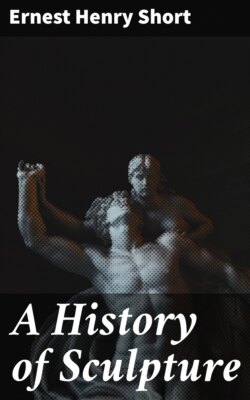Читать книгу A History of Sculpture - Ernest Henry Short - Страница 8
На сайте Литреса книга снята с продажи.
THE GROWTH OF NATURALISM
(550 b.c. TO 480 b.c.)
ОглавлениеThe Ionic Colonies in Asia Minor were the first of the Greek-speaking races to acquire material prosperity, and it was there that the sculptor first began to shake off the old conventional shackles. The Ionians were in touch with the civilisations of Babylonia and Egypt, and merchandise from the East flowed through their markets for Greece and the Grecian Colonies in the far west. Sculpture, in which the Oriental influence was strongly marked, flourished there considerably earlier than in Argos or Attica. About the middle of the seventh century b.c. these Ionian Colonies began to influence Greece strongly, and Athens in particular. This is evidenced by the manner in which the Ionic linen chiton, or sleeved tunic, gradually superseded the woollen peplos which the Athenians had worn earlier.
At this time the Greeks were becoming richer; their Colonies continued to demand ever increasing quantities of their manufactures, and to send more and more of the raw materials. The greater cities were able to replace the old shrines of brick and wood, which had contained the wooden images of their gods, by new stone structures. During the second half of the sixth century, temples were erected all over the Greek-speaking world, the ruins of those at Ægina and Selinus still remaining to show us the general type. Sculpture was the twin sister of architecture. Pediments, metopes, and friezes were all adorned with marble groups or reliefs. In Greece proper, the tyrants, who had usurped the power in many States, spent vast sums on beautifying their capitals. Such a one as Pisistratus turned to Ionia for the craftsmen he needed, and, particularly, to the school of sculpture in the island of Chios. Many Ionians skilled in the working of marble from Naxos and Paros settled in Athens, and they instructed their Athenian brethren. With the increasing facility that resulted from the greater number of workmen who could give their lives to mastering its technical difficulties, sculpture gradually lost its conventionalities.
By this time the art had made immense strides beyond the rude wooden images of the earlier age, as can be seen from the well-known archaistic “Diana,” in the National Museum, Naples. This particular work was executed in Roman times under the influence of a strong tendency to reproduce the prominent characteristics of the archaic style. But though it dates from a time when sculpture was once more falling into lifeless conventionalism, it gives a good idea of the results of the first earnest efforts after truthful representation. The sculptor is not yet master of his material. Note the strange expression known as “the archaic smile,” a direct consequence of the craftsman’s inability to represent correctly the human eye in profile.
DEDICATORY STATUE (ARCHAIC)
Acropolis Museum, Athens
DIANA (ARCHAISTIC)
National Museum, Naples
A number of painted archaic sculptures have been unearthed in recent years on the Athenian Acropolis, which show the originals upon which the archaistic style of the “Diana” at Naples was formed. They were buried during the improvements consequent upon the rebuilding after the Persian Wars. Many of these were dedicatory offerings. The increasing custom of substituting such statues for the tripods and craters dedicated in earlier days, did much to provide artists at the end of the sixth, and the beginning of the fifth century, with opportunities for experiment. In such work the artist had only to satisfy the donor. Private individuals were less insistent upon conventional forms than the temple priests. Under these influences the drapery gradually became less angular, and the set smile of the older statues gave place to a dignified repose. The illusion of form became more and more complete, and there was less and less insistence upon the reproduction of the detail in every fold of the elaborate Ionic drapery. In other words, the artist was no longer a slave to his material. He was learning how to make the marble express what he had in mind. The numerous discoveries of these archaic statues illustrate the gradual change and, particularly, the growing beauty after which the Athenian artists were striving. Incidentally, they afford interesting evidence of the practice of painting marble which was general in Greece. From the remains of the actual pigments used, it can be seen that the hair was coloured, and the brow, lashes, pupil and iris of the eye indicated. The borders of the dress too were strongly marked, so that one garment could be readily distinguished from another.
With the growing naturalism even portrait statues became possible. For instance, after the dismissal of the sons of Pisistratus, a group in honour of Harmodius and Aristogiton, who had headed an insurrection against the tyrant, was erected in the Agora by their democratic admirers. When this was carried off by Xerxes, it was replaced by a group, the work of Critius and Nesiotes, a marble copy of which can be seen in the National Museum at Naples. We have chosen the statue of “Harmodius” as an illustration of the earliest Greek iconic statuary. It will be seen that it entirely lacks the ideality of treatment which was to be the leading characteristic of the art fifty years later.
